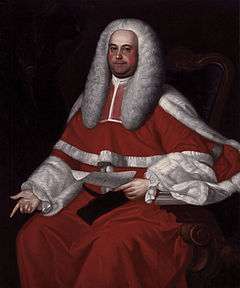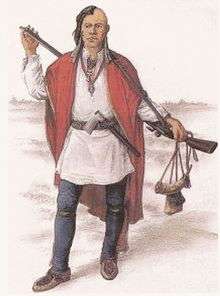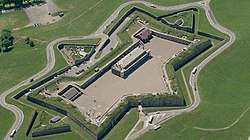Halifax Treaties

Halifax Treaties were 11 written documents signed by the various bands of the Mi’kmaq and the British in Halifax, Nova Scotia between 1760 and 1761.[1] The Treaties ended the conflict that had persisted between the two peoples for 85 years. The Treaties include both military submissions, or oaths of allegiance made at the three fortresses in the region followed by treaties signed at Halifax,[2] as well as the oral promises made during Treaty ceremonies to guarantee the Mi'kmaq the protection and rights as British subjects. The ceremony with the most primary sources was the Burying the Hatchet ceremony, which happened on 25 June 1761. While most historians have concluded that the language of the Treaties clearly reflect that the Mi'kmaq surrender to the British, other historians have suggested otherwise.[3][4]
Context
| Military history of Mi’kmaq people | ||||||||||||||||||||||||||||||||||||||||||||||||||||||||||||||||
|---|---|---|---|---|---|---|---|---|---|---|---|---|---|---|---|---|---|---|---|---|---|---|---|---|---|---|---|---|---|---|---|---|---|---|---|---|---|---|---|---|---|---|---|---|---|---|---|---|---|---|---|---|---|---|---|---|---|---|---|---|---|---|---|---|
 Mi’kmaq Warrior | ||||||||||||||||||||||||||||||||||||||||||||||||||||||||||||||||
| Events | ||||||||||||||||||||||||||||||||||||||||||||||||||||||||||||||||
|
||||||||||||||||||||||||||||||||||||||||||||||||||||||||||||||||
| Other | ||||||||||||||||||||||||||||||||||||||||||||||||||||||||||||||||
|
| ||||||||||||||||||||||||||||||||||||||||||||||||||||||||||||||||
During the final period of the French and Indian War, French Officers, Mi’kmaq and Acadians carried out military strikes against the British. The Mi'kmaq and their French allies conducted the Northeastern Coast Campaign (1755) in Maine and extended this campaign into Nova Scotia, attacking civilians during the raids on Lunenburg. Following the British capture of Louisbourg in 1758, Quebec in 1759, and Montreal in 1760, French imperial power was destroyed in North America. There were 300 Mi'kmaw fighters in the region compared to many more British regulars and rangers. After the defeat of the French, the Mi’kmaq no longer had a source of guns and ammunition to fight or even hunt for food. The Mi’kmaq immediately asked the British for guns and ammunition, claiming that "the French always Supplyed Them with these Things and They expect that we will do the Same."[5] According to those at Louisbourg, after the defeat the Mi’kmaq wanted bread and had "no prospect of relief." By the spring of 1760, General Amherst determined that the Mi’kmaq and Acadians posed no significant threat to British control of the region, and that provincial forces were adequate to meet the defence needs of Nova Scotia.[6]
The Mi'kmaq had long experience with international diplomacy and Treaty-making. They had formed the Wabanaki Confederacy with the Maliseet, Passamaquoddy, Penobscot, and Abenaki, possibly prior to European arrival, and had also entered into a broader alliance with the Iroquois and the Odawa in the late 17th century. Both alliances lasted for centuries.[7] Further, the Wabanaki Confederacy had been capable of inviting the French to settle in their territory in 1603 and maintaining a consistent peace with the French, although they never created Treaties. The Mi'kmaq did, however, enter into a Concordat with the Vatican in 1610.[8]
Primarily because of the influence of the French, however, British attempts to legalize the relationship through Treaty-making between the Mi'kmaq had initially had limited success. The first Treaty, which was negotiated by the Penobscot, and subsequently ratified by the Mi'kmaw, Maliseet, and Passamaquoddy in 1726, formally brought to an end a 3 year war between the Wabanaki and the New England colonies.[9] This Treaty largely kept the Peace until the outbreak of King William's War in 1744.[10]
Subsequent Treaties also had limited success: the 1749 Treaty was only signed by the Mi’kmaw band at Chignecto; the 1752 Treaty was only signed by Shubenacadie and was renounced 6 months after it was signed.
Treaty-making was made more difficult by the complex, consensus-based governance system of the Mi'kmaq. While the Mi'kmaq were united by common ties of language, culture, and kinship, they were also a highly decentralized people, made up of autonomous local communities, each of which had its own sakamow or chief. Although they often met to deliberate issues of importance to the Nation, there was no central authority that could act for all.[11] Once Treaty terms were established, runners were sent to each community to communicate the terms. Communities then debated whether they would ratify a particular Treaty, after which they would usually attend a signing ceremony in a central location, such as Halifax.[12]
The Treaties
Treaty negotiations began soon after the conquest of Quebec with the Maliseet and the Passamaquoddy in late November 1759. A Treaty was concluded at Halifax on February 22, 1760, and later ratified by individual Maliseet and Passamaquoddy communities at Fort Frederick (Saint John, New Brunswick). This Maliseet-Passamaquoddy treaty formed the basis on which later treaties were signed with individual Mi'kmaq communities in 1760 and 1761: on March 10, 1760 with the Mi'kmaq of Shubenacadie, La Have, and Richibuctou; on June 25, 1761 with the Mi'kmaq of Cape Breton, Miramichi, Pokemouche, Shediac; on July 81, 1761 with the Mi'kmaq of Chignecto/Missiquash, and on October 12, 1760 with the Mi'kmaq of Pictou/Malogomich.[13]
Unlike the Maliseet-Passamaquoddy Treaty, the Halifax Treaties with the Mi'kmaq did not explicitly renew earlier treaties that were negotiated between the Mi'kmaq and the British. One historian has argued that, for many Mi’kmaw communities they had never subscribed to earlier Nova Scotia treaties, so there was thus nothing to renew.[14] However, others have pointed out continuity between the 1726 treaty and those signed in l760 and 1761, notably, that the first six articles of the Halifax Treaties correspond to the first six articles of the 1726 treaty, with some modifications. As such, it seems that the British and the Mi'kmaq considered the 1726 treaty to form the basis of their relationship.[15]
All the Halifax Treaties began with the Mi’kmaw chief acknowledging the jurisdiction and dominion of King George over the territories of Nova Scotia. The Mi'kmaq promised not to molest the British migrants. The Mi’kmaw promised to make restitution for robbery or violence and use the law courts to resolve conflicts. The Mi'kmaq promised to free English prisoners, to have nothing further to do with the French, and to report any of their ill designs against the British. Lastly, they agreed to confine their trade to government truckhouses, where they would leave some of their number as hostages to guarantee their good behaviour.[16]
The Supreme Court of Canada has interpreted the "truckhouse" clause as providing a right to hunt, fish and gather to secure necessary goods for trade to earn a moderate livelihood. The court noted that restricting Trade with their enemies like the French, while undermining unregulated private traders, was seen as important to cementing the fragile peace [17]
Many historians have concluded that the Treaties clearly indicate that the Mi'kmaq surrendered to the British.[18] Some historians have suggested that, because the Halifax Treaties did not specifically stipulate the surrender of land by the Mi'kmaq, that the British Crown did not claim the land through the treaty.[19] (Earlier Treaties did not stipulate land ownership, however, future treaties in other parts of Canada do mention land ownership.)
Oral promises made during Treaty ceremonies to guarantee the Mi'kmaq the same rights as other British subjects is also considered by some historians as an important part of the understanding of the Treaty relationship. At the Burying the Hatchet Ceremony (Nova Scotia) in 1761, Jonathan Belcher told the Mi’kmaq "The Laws will be like a great Hedge about your Rights and properties." Belcher told the Mi’kmaq were now British subjects and that those in Nova Scotia are "your fellow subjects." Further, he indicated that the Mi’kmaq would fight along side other British subjects, side by side, "that your cause of war and peace may be the same as ours under one mighty Chief and King, under the Same Laws and for the same Rights and Liberties." The Mi’kmaw Chief from Cape Breton concurred: "As long as the Sun and Moon shall endure ... so long will I be your friend and ally, submitting myself to the Laws of your Government, faithful and obedient to the Crown."[20]
Afterward
The Mi'kmaq began their accommodation with British law, as they had promised. The British, according to Patterson, "accepted a continuing role for existing Mi'kmaw polities within the limits of British sovereignty."[21] For example, when New Brunswick was being established in 1784, Mi’kmaq were asking that "certain lands be reserved and protected to them by licenses of occupation, similar to those being issued to new settlers."[22]
There was a serious challenge to the treaties during the American Revolution. The Americans were trying to recruit the Mi’kmaq to fight against the British. In response, the Superintendent of Indian affairs in Nova Scotia, Michael Francklin attended a meeting in which the Mi’kmaq renewed their oath of allegiance to the British Crown.[23] When conflict did happen between a small group of Mi’kmaq and the British on the Miramichi, the Local Mi’kmaq leadership approved the British capture of the rebels, the removal of the rebel chief and the appointment of a new chief. The Mi’kmaq provided a copy of the 1760 Treaty for the new chief to sign. Two months later, Mi’kmaw chiefs signed the treaty of 1779 with the British at Windsor, Nova Scotia. According to historian Stephen Patterson, "The vast majority of Mi’kmaq did not join in challenging British authority – to the contrary they took steps to aid British military and civilian officials in suppressing the disorders and restoring peace."[24]
During the American Revolution, the Americans signed the Treaty of Watertown with the Mi'kmaw as a means of drawing their support away from the British. The Mi'kmaq continued to pressure the British Government throughout the nineteenth century to have the British live up to the Treaties and treat the Mi'kmaq like full British subjects as they did those from other cultures who were British subjects.
Mi'kmaq Sovereignty
Some historians have argued that the Treaties were not Treaties of surrender and that, in fact, Nova Scotia is "unceded Mi'kmaw territory". To sustain this argument, some historians have argued that the Mi'kmaq were in a strong enough position to negotiate the terms of the Halifax Treaties and make demands of their own of the British. John Reid asserts that the Mi'kmaq military power in the region did not wane until decades after the French had been defeated. (In contrast, some commentators, such as Daniel N. Paul, argue that a decade before the Halifax Treaties were signed, the Mi'kmaq were weakened because they experienced a genocide by Governor Edward Cornwallis.)[25] Reid dismisses the statements in the Treaties about Mi'kmaq surrender or submission to the British crown, by asserting that there is significant evidence surrounding the Treaties that suggest the real intent of the Treaties was to establish friendly and reciprocal relationships. The Mi'kmaq leaders who came initially to Halifax in 1760 had clear goals that centred on the making of peace, the establishment of a secure and well-regulated trade in commodities such as furs, and an ongoing friendship with the British crown. In return, they offered their own friendship and a tolerance of limited British settlement, although without any formal land surrender.[26] To fulfill the friendly and reciprocal intent of the treaties, Reid asserts further British settlement of land would need to be negotiated and, in exchange for sharing the land, presents would be given to the Mi'kmaq. According to historian Geoffrey Plank, the documents summarizing the peace agreements did not indicate the laws regulating land ownership and land usage, but they assured the Mi’kmaq access to the natural resources that had long sustained them along the regions’ coasts and in the woods.[27]
Reid asserts that the Mi'kmaq military power only began to wane in the region when the New England Planters and United Empire Loyalists began to arrive in Mi'kma'ki in greater numbers, economic, environmental and cultural pressures were put on the Mi'kmaq with the erosion of the intent of the treaties. According to Reid, Mi'kmaq tried to enforce the treaties through threat of force as some did in the American Revolution at the Miramichi. Similarly, Tod Scott has argued that the Mi'kmaq were able to keep the British "holed up" in their forts until the French were defeated in the region and the Mi'kmaq no longer had a supply of arms.[28] The Supreme Court of Canada also stated in R. v. Marshall that "the British feared the possibility of a renewed military alliance between the Mi’kmaq and the French as late as 1793." [29]
Those who assert Mi'kmaq sovereignty rely in part on the evidence of the Treaty of Watertown. Again, the Americans made the treaty to draw Mi'kmaq support away from the British during the American Revolution. The Mi'kmaq signed the Treaty of Watertown with the new United States of America. The Treaty acknowledged the Mi'kmaq ability to continue trade. The Treaty was part of the basis for neutral position taken by the Mi'kmaq during the War of 1812 and why Mi'kmaq took marooned American sailors back to the US without ransom. There has never been a formal objection by Britain or Canada to this treaty or situation.
As Mi'kmaq military power waned in the beginning of the nineteenth century, as some historians have argued, rather than interpreting the Mi'kmaq treaty demands as demands to be treated like full British subjects, Reid asserts the Mi'kmaq treaty demands were about expecting the British to give presents for the Mi'kmaq accommodating them on their land. The British responded by giving presents and educational opportunities, which Reid interprets as further subjugation.[30]
See also
References
Texts
- Alexander Cameron. Power without Law: The Supreme Court of Canada, the Marshall Decisions and the Failure of Judicial Activism. McGill-Queen's Press. 2009.
- Stephen Patterson. Eighteenth-Century Treaties:The Mi’kmaq, Maliseet, and Passamaquoddy Experience. Native Studies Review 18, no. 1 (2009).
- John G. Reid. "Empire, the Maritime Colonies, and the Supplanting of Mi’kma’ki/Wulstukwik, 1780-1820." Acadiensis, 38:2 (Summer/Autumn 2009), 78-97.
- John G. Reid. "Amerindian Power in the Early Modern Northeast: A Reappraisal." William and Mary Quarterly, 3rd series, 61 (2004), 77-106. Co-authored with Emerson W. Baker.
- William Wicken. Treaties on Trial: History, Land and Donald Marshall Junior. University of Toronto Press. 215-218
Endnotes
- ↑ There were also Halifax Treaties signed with the Wolastoqiyik (Maliseet) and the Passamaquoddy.
- ↑ Patterson, p. 46
- ↑ Stephen Patterson. Eighteenth-Century Treaties:The Mi’kmaq, Maliseet, and Passamaquoddy Experience. Native Studies Review 18, no. 1 (2009).
- ↑ Wicken, Treaty of Peace and Friendship 1760
- ↑ Patterson, p. 39
- ↑ As a result, British began closing down forts such as Fort Ellis.
- ↑ Robert Hamilton, "Indigenous Legal Traditions and Histories of International and Transnational Law in the Pre-Confederation Maritime Provinces", Center for International Governance Innovation, January 2018, https://www.cigionline.org/publications/indigenous-legal-traditions-and-histories-international-and-transnational-law-pre
- ↑ See James (Sakej) Youngblood Henderson, The Mi'kmaw Concordat", Fernwood Publishing !997)
- ↑ William Wicken, "Treaty of Peace and Friendship 1760", available at: https://www.aadnc-aandc.gc.ca/eng/1100100028599/1100100028600
- ↑ For a detailed discussion of the treaty process of 1725–1726, see Stephen E. Patterson, "Anatomy of a Treaty: Nova Scotia’s First Native Treaty in Historical Context," UNB Law Journal 48 (1999): 41–64.
- ↑ Patterson, p. 43
- ↑ For a more detailed discussion of Mi'kmaq Governance and the Treaty Process, see Rosalie Francis, (2003)"The Mi’kmaq nation and the Embodiment of Political Ideologies: Ni’kmaq, Protocol and Treaty Negotiations in the Eighteenth Century," M.A. Thesis, Saint Mary’s University.
- ↑ Wicken
- ↑ Patterson, p. 44
- ↑ Wicken, Treaty of Peace and Friendship 1760
- ↑ Patterson, p. 44
- ↑ R. v. Marshall, [1999] 3 SCR 456, at para 94
- ↑ Stephen Patterson. Eighteenth-Century Treaties:The Mi’kmaq, Maliseet, and Passamaquoddy Experience. Native Studies Review 18, no. 1 (2009).
- ↑ Wicken, Treaty of Peace and Friendship 1760
- ↑ Patterson, pp. 45-46
- ↑ Patterson, p. 51
- ↑ Patterson, p. 49
- ↑ Patterson, p. 50
- ↑ Patterson, p. 46
- ↑ See Daniel Paul. We Were Not the Savages and Jon Tattrie. Cornwallis.
- ↑ John Reid. Nova Scotia: A Pocket History. Fernwood Press. 2009. p. 23
- ↑ Plank, Unsettled Conquest. p. 163
- ↑ Tod Scott, "Mi’kmaw Armed Resistance to British Expansion in Northern New England (1676–1761)", Journal of the Royal Nova Scotia Historical Society, Vol. 19, 2016
- ↑ R. v. Marshall, [1999] 3 SCR 456, at para 94
- ↑ Reid. p. 26
